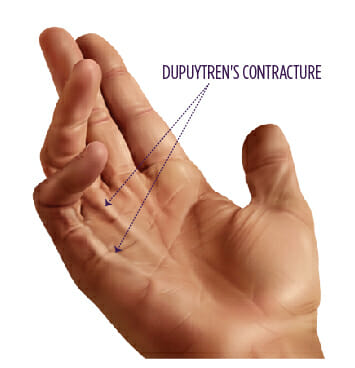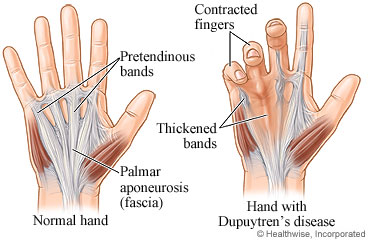Dupytren’s Disease

Dupytren’s disease is a hand contracture that usually develops over several years. The condition affects a layer of tissue, known as fascia that lies under the skin of your palm. It usually begins as a thickening of the skin and as it progresses, the skin in the palm may appear dimpled. A firm lump can form and may be tender to touch but usually is not painful. Eventually, a thick cord may develop that can pull one or more fingers into a bent position. The ring and small fingers are most affected. When the involved fingers cannot be straightened completely, it can lead to difficulty performing everyday tasks such as placing your hand in your pocket, shaking hands, clapping or putting on gloves.
Approximately 10 million Americans have Dupytren’s and the causes of Dupytren’s are unknown. A number of risk factors are believed to increase the risk of the disease including: age > 50, males, people of Northern European descent, family history, tobacco, and alcohol use, and diabetes.
If the disease progresses slowly, causes no pain, and has little impact on your ability to perform everyday tasks, then most likely no treatment is indicated. If the condition is mild, there are things you can do to protect your hands including: avoiding tight grip on tools, building up handle diameter with cushion tape, or using padded gloves during heavy gripping. Treatment for progressive worsening of the disease may include needling, enzyme injections or surgery to break up the diseased tissue. No matter what treatment you get, be aware that it will not remove the disease and recurrence is common! It is important to not wait too long to have a procedure. If the fingers have become severely contracted, the chance of having a straight finger after the procedure becomes less likely.

It is important to seek out a hand surgeon or professional as soon as you have symptoms! Dupytren’s is commonly misdiagnosed and getting the proper treatment sooner rather than later is ideal. Hand therapy following any of these procedures may be beneficial. A hand therapist can make a custom orthosis to keep the fingers extended, assist with tissue healing and scar management and help you to improve the functional use of your hand for daily activities.
References
Sweet S, Blackmore S. Surgical and therapy update on the management of Dupytren’s disease, Journal of Hand Therapy 2014; 27: 77-84.
Engstrand C, Boren L, Liedberg G.M. Evaluation of Activity Limitation and Digital Extension in Dupytren’s Contracture Three Months after Fascietomy and Hand Therapy Interventions, Journal of Hand Therapy 2009; 21-26.
Hurst L, Dupytren’s Disease: Surgical Management, Rehabilitation of the Hand and Upper Extremity, Sixth Edition 2011; 22: 266-280
Evans R, Therapeutic Management of Dupytren’s Contracture, Rehabilitation of the Hand and Upper Extremity, Sixth Edition 2011; 23: 281-288.
American Society for Surgery of the Hand, HandCare Blog
